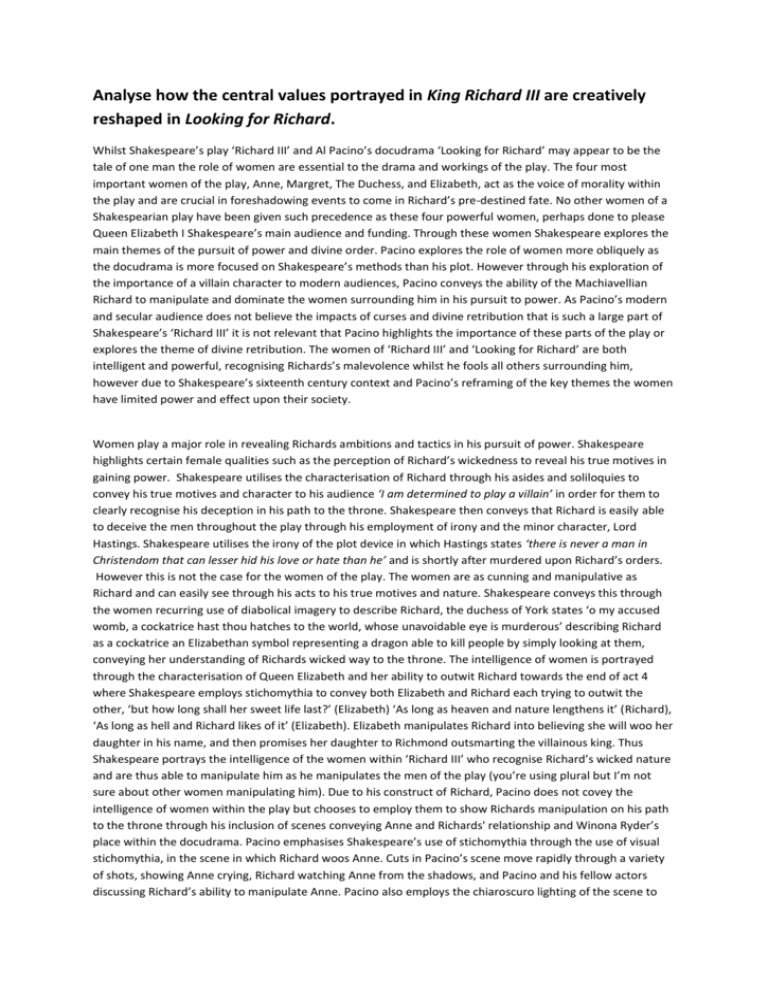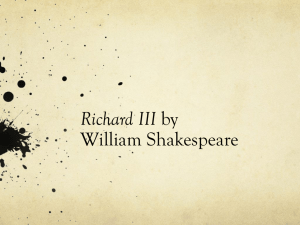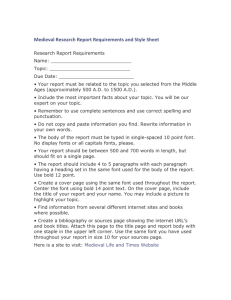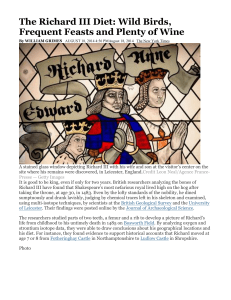Gender Essay on Looking for Richard and Role of Women
advertisement

Analyse how the central values portrayed in King Richard III are creatively reshaped in Looking for Richard. Whilst Shakespeare’s play ‘Richard III’ and Al Pacino’s docudrama ‘Looking for Richard’ may appear to be the tale of one man the role of women are essential to the drama and workings of the play. The four most important women of the play, Anne, Margret, The Duchess, and Elizabeth, act as the voice of morality within the play and are crucial in foreshadowing events to come in Richard’s pre-destined fate. No other women of a Shakespearian play have been given such precedence as these four powerful women, perhaps done to please Queen Elizabeth I Shakespeare’s main audience and funding. Through these women Shakespeare explores the main themes of the pursuit of power and divine order. Pacino explores the role of women more obliquely as the docudrama is more focused on Shakespeare’s methods than his plot. However through his exploration of the importance of a villain character to modern audiences, Pacino conveys the ability of the Machiavellian Richard to manipulate and dominate the women surrounding him in his pursuit to power. As Pacino’s modern and secular audience does not believe the impacts of curses and divine retribution that is such a large part of Shakespeare’s ‘Richard III’ it is not relevant that Pacino highlights the importance of these parts of the play or explores the theme of divine retribution. The women of ‘Richard III’ and ‘Looking for Richard’ are both intelligent and powerful, recognising Richards’s malevolence whilst he fools all others surrounding him, however due to Shakespeare’s sixteenth century context and Pacino’s reframing of the key themes the women have limited power and effect upon their society. Women play a major role in revealing Richards ambitions and tactics in his pursuit of power. Shakespeare highlights certain female qualities such as the perception of Richard’s wickedness to reveal his true motives in gaining power. Shakespeare utilises the characterisation of Richard through his asides and soliloquies to convey his true motives and character to his audience ‘I am determined to play a villain’ in order for them to clearly recognise his deception in his path to the throne. Shakespeare then conveys that Richard is easily able to deceive the men throughout the play through his employment of irony and the minor character, Lord Hastings. Shakespeare utilises the irony of the plot device in which Hastings states ‘there is never a man in Christendom that can lesser hid his love or hate than he’ and is shortly after murdered upon Richard’s orders. However this is not the case for the women of the play. The women are as cunning and manipulative as Richard and can easily see through his acts to his true motives and nature. Shakespeare conveys this through the women recurring use of diabolical imagery to describe Richard, the duchess of York states ‘o my accused womb, a cockatrice hast thou hatches to the world, whose unavoidable eye is murderous’ describing Richard as a cockatrice an Elizabethan symbol representing a dragon able to kill people by simply looking at them, conveying her understanding of Richards wicked way to the throne. The intelligence of women is portrayed through the characterisation of Queen Elizabeth and her ability to outwit Richard towards the end of act 4 where Shakespeare employs stichomythia to convey both Elizabeth and Richard each trying to outwit the other, ‘but how long shall her sweet life last?’ (Elizabeth) ‘As long as heaven and nature lengthens it’ (Richard), ‘As long as hell and Richard likes of it’ (Elizabeth). Elizabeth manipulates Richard into believing she will woo her daughter in his name, and then promises her daughter to Richmond outsmarting the villainous king. Thus Shakespeare portrays the intelligence of the women within ‘Richard III’ who recognise Richard’s wicked nature and are thus able to manipulate him as he manipulates the men of the play (you’re using plural but I’m not sure about other women manipulating him). Due to his construct of Richard, Pacino does not covey the intelligence of women within the play but chooses to employ them to show Richards manipulation on his path to the throne through his inclusion of scenes conveying Anne and Richards' relationship and Winona Ryder’s place within the docudrama. Pacino emphasises Shakespeare’s use of stichomythia through the use of visual stichomythia, in the scene in which Richard woos Anne. Cuts in Pacino’s scene move rapidly through a variety of shots, showing Anne crying, Richard watching Anne from the shadows, and Pacino and his fellow actors discussing Richard’s ability to manipulate Anne. Pacino also employs the chiaroscuro lighting of the scene to depict Richard as a powerful and enigmatic figure who is easily able to find and target the weaknesses of Anne. Through these techniques Pacino reshapes Richard’s wit from the play into sexual power for greater understanding by his modern day audience and conveys women as a stepping stone in Richard’s pursuit of power. Following this Pacino includes a scene within his docudrama where Kimball establishes Pacino’s authority over Ryder, the plot device of Kimball interrupting Ryder to mock her during a workshop portrays Anne/Ryder as subservient to Pacino/Richard and further highlights Pacino’s views on the minor role of women in Shakespearian society and ‘Richard III’. Thus despite the acceptance of gender equality during his twentieth century context Pacino does not portray the intelligence of women as Shakespeare does within ‘Richard III’ in order to highlight the intelligence of his Machiavellian Richard. Throughout ‘Richard III’ Shakespeare portrays women, especially Margret, as the force of predestination, fate and divine retribution against Richard’s sacrilegious actions. Although Margret does not physically appear often in the play she keeps a watchful eye over the family, and exerts her power over the family through her prophecies and curses. Shakespeare employs Margret’s asides in order to covey her prophetic nature ‘a murderous villain... which god revenge!’ Margret’s prophecies and curses become a recurring motif within the play and are employed by Shakespeare as a symbol of divine intervention and retribution. Shakespeare employs the plot device of Margret cursing the royal family and her soliloquies ‘but remember this another day... say poor Margret was a prophetess’ contrasted with later scenes and such as Grey’s exclamation ‘now Margret’s curse is fallen upon our heads, for standing by when Richard stabbed her son’ to portray the playing out of Margret’s curses as divine retribution. Thus Shakespeare conveys Margret’s important role as a woman as a force of fate and divine retribution. Shakespeare’s construction of the role of women is not relevant to Pacino’s secular and humanist society who do not believe in curses and divine retribution, thus Pacino does not focus on the role of women as prophetess’ and the bringers of divine retribution. Through his characterisation of Margret, Pacino employs his voiceover to portray her as a ‘ghost of the past, who haunts the yorks’ confirmed by her costume of faded clothes, a discoloured crown and messy hair conveying her time has passed and she in now just a nuisance to the York family. Close up shots on the faces of the York family looking slightly amused whilst Margret curses them undercuts Margret’s curses and prophecies conveying their lack of importance to Pacino’s twentieth century secular audience. Thus through his portrayal of Margret and her curses Pacino downplays the importance of divine retribution and prophecies within the play to create a greater force understanding for his audience. Hence both Shakespeare and Pacino explore the role of women as a force of divine retribution differently due to Shakespeare’s providential and highly religious context and Pacino’s contemporary audience’s humanist and secular beliefs. Both ‘Richard III’ and ‘Looking for Richard’ are products of different times yet they are connected through their explorations of the role of women. Shakespeare conveys important female qualities in their ability to recognise and manipulate Richards’s true nature and as a force of divine retribution painting their important role in society. Pacino in his docudrama ‘Looking for Richard’ reframes Shakespeare’s original play ‘Richard III’ in order to bring the Tudor drama and its religious context, to his twentieth century secular and humanist audience, choosing to focus less on the intelligence of the powerful woman instead portraying woman as a stepping stone in Richards achievement of power. Through a study of the contexts and values of the texts, the responder gains insight into the important female qualities that are highlighted within ‘Richard III’.








